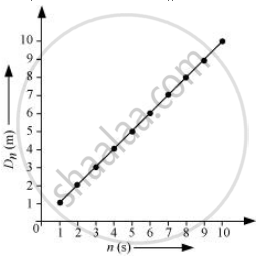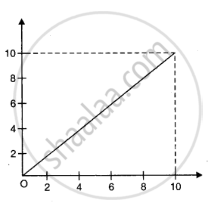Advertisements
Advertisements
प्रश्न
A three-wheeler starts from rest, accelerates uniformly with 1 m s–2 on a straight road for 10 s, and then moves with uniform velocity. Plot the distance covered by the vehicle during the nth second (n = 1,2,3….) versus n. What do you expect this plot to be during accelerated motion: a straight line or a parabola?
उत्तर १
Straight line
Distance covered by a body in nth second is given by the relation
`D_n = u + a/2 (2n -1)` ....(i)
Where,
u = Initial velocity
a = Acceleration
n = Time = 1, 2, 3, ..... ,n
In the given case,
u = 0 and a = 1 m/s2
`:.D_n = 1/2(2n-1)` ....(ii)
This relation shows that:
Dn ∝ n … (iii)
Now, substituting different values of n in equation (iii), we get the following table:
| n | 1 | 2 | 3 | 4 | 5 | 6 | 7 | 8 | 9 | 10 |
| Dn | 0.5 | 1.5 | 2.5 | 3.5 | 4.5 | 5.5 | 6.5 | 7.5 | 8.5 | 9.5 |
The plot between n and Dn will be a straight line as shown:

Since the given three-wheeler acquires uniform velocity after 10 s, the line will be parallel to the time-axis after n = 10 s
उत्तर २
Since `S_(n^(th)) = u+ 1/2a(2n-1)`
when u = 0, a = 1 `ms^(-2)`
`:.S_(n^(th)) = 0 + 1/2(2n-1) = 1/2(2n-1)`
`:. For n = 1,2,3....`
`S_1 = 1/2(2xx1-1) = 0.5 m`
`S_2 = 1/2(2xx2-1) = 1.5 m`
`S_3 = 1/2 (2xx3-1) = 2.5 m`
`S_4 = 1/2(2xx4-1)= 3.5 m`
`S_5 = 1/2(2xx5-1) = 4.5 m`
`S_6 = 1/2(2xx6-1) = 5.5 m`
`S_7 = 1/2(2xx7-1) = 6.5 m`
`S_8 = 1/2(2xx8-1) = 7.5 m`
`S_9 = 1/2(2xx9-1) = 8.5m`
`S_10 =1/2 (2xx10-1)= 9.5 m`

APPEARS IN
संबंधित प्रश्न
The velocity of a particle is towards west at an instant. Its acceleration is not towards west, not towards east, not towards north and towards south. Give an example of this type of motion .
A train starts from rest and moves with a constant acceleration of 2.0 m/s2 for half a minute. The brakes are then applied and the train comes to rest in one minute. Find the total distance moved by the train .
A particle starting from rest moves with constant acceleration. If it takes 5.0 s to reach the speed 18.0 km/h find the average velocity during this period .
A stone is thrown vertically upward with a speed of 28 m/s. change if the initial speed is more than 28 m/s such as 40 m/s or 80 m/s ?
A person standing on the top of a cliff 171 ft high has to throw a packet to his friend standing on the ground 228 ft horizontally away. If he throws the packet directly aiming at the friend with a speed of 15.0 ft/s, how short will the packet fall?
A ball is projected from a point on the floor with a speed of 15 m/s at an angle of 60° with the horizontal. Will it hit a vertical wall 5 m away from the point of projection and perpendicular to the plane of projection without hitting the floor? Will the answer differ if the wall is 22 m away?
A swimmer wishes to cross a 500 m wide river flowing at 5 km/h. His speed with respect to water is 3 km/h. If he heads in a direction making an angle θ with the flow, find the time he takes to cross the river.
A swimmer wishes to cross a 500 m wide river flowing at 5 km/h. His speed with respect to water is 3 km/h. Find the shortest possible time to cross the river.
Suppose A and B in the previous problem change their positions in such a way that the line joining them becomes perpendicular to the direction of wind while maintaining the separation x. What will be the time B finds between seeing and hearing the drum beating by A?
A ball is dropped from a building of height 45 m. Simultaneously another ball is thrown up with a speed 40 m/s. Calculate the relative speed of the balls as a function of time.
